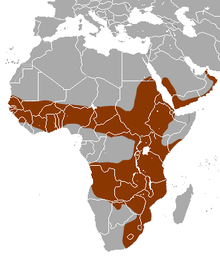White tailed mongoose
| White tailed mongoose | ||||||||||||
|---|---|---|---|---|---|---|---|---|---|---|---|---|

White-tailed mongoose ( Ichneumia albicauda ) |
||||||||||||
| Systematics | ||||||||||||
|
||||||||||||
| Scientific name of the genus | ||||||||||||
| Ichneumia | ||||||||||||
| I. Geoffroy Saint-Hilaire , 1837 | ||||||||||||
| Scientific name of the species | ||||||||||||
| Ichneumia albicauda | ||||||||||||
| ( G. Cuvier , 1829) |
The white-tailed mongoose ( Ichneumia albicauda ), also called Weißschwanzichneumon is, one in Africa and on the Arabian Peninsula living carnivore species from the family of mongooses (Herpestidae).
features
White-tailed mongooses are among the largest members of their family and reach a head body length of 47 to 71 centimeters, a tail length of 34 to 47 centimeters and a weight of 1.8 to 5.2 kilograms. The undercoat is yellowish or white, black outer hair protruding from it gives the animal a grayish overall impression. The limbs are black from the knees. The name-giving feature is the white-colored rear half of the bushy tail, but this can also be black in individual animals.
distribution and habitat
White-tailed mongooses are distributed over large parts of Africa, they come from Senegal and southern Egypt to northern Namibia and eastern South Africa , but avoid pronounced forest and desert areas. In addition, they are common in the southern half of the Arabian Peninsula . Their habitat is primarily savannahs and grasslands, where they prefer areas with dense vegetation such as forest edges or river banks.
Way of life
These animals are nocturnal, during the day they hide in the burrows of porcupines or aardvarks or in caves. They are loners, whereby the males defend their territories against same-sex conspecifics - with those of females they can overlap over a large area.
The diet of these animals consists primarily of insects, but they also eat snakes and other vertebrates, as well as fruits.
The births fall in the wetter months of the year, the litter size is between one and four newborns. The gestation period is estimated to be around 60 days, with around nine months the young animals are independent.
White tailed mongooses and humans
These animals are widespread and, according to the Red List of Endangered Species of the International Union for Conservation of Nature ( IUCN), belong to the non-threatened species (“Least Concern”).
In some regions they are feared as they invade poultry houses and kill the animals in them.
literature
- Ronald M. Nowak: Walker's Mammals of the World . Johns Hopkins University Press, 1999 ISBN 0-8018-5789-9
Web links
- Ichneumia albicauda in the endangered Red List species the IUCN 2009. Posted by: Hoffmann, M., 2008. Accessed on 26/01/2010.
- More information and pictures (English)
